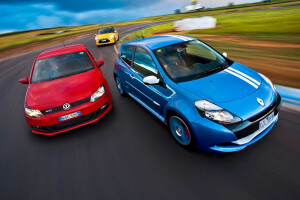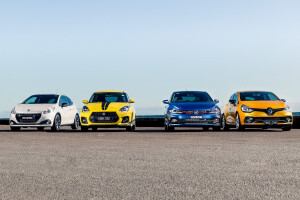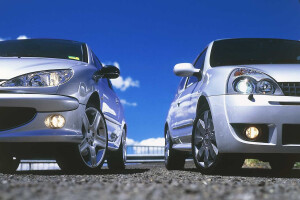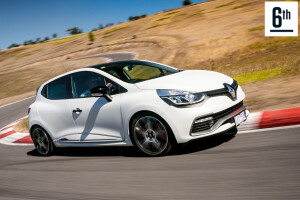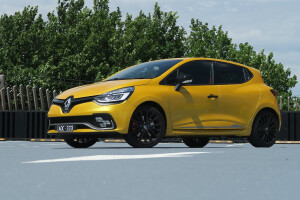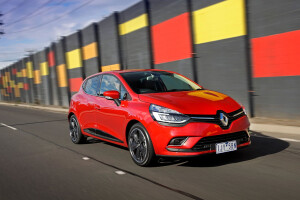Latest Review
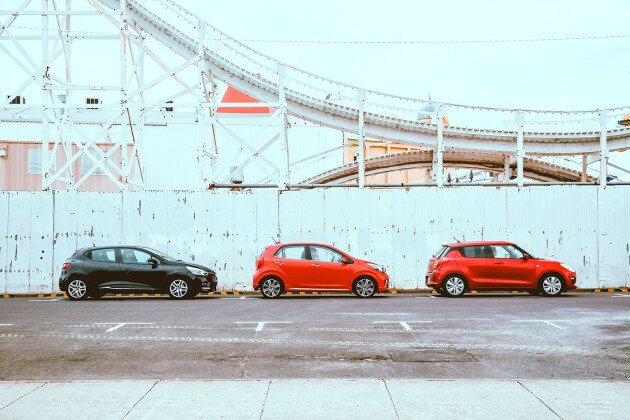
Kia Picanto GT vs Suzuki Swift GL Navigator vs Renault Clio Life Comparison
How much fun does $17K afford? We trial a trio of terrific, pint-sized tearabouts that will crank plenty of smiles without breaking the bank
OH! Won’t somebody please think of the children!” Or at least the teens.
Over the past few years, more than a handful of sub-$20,000 superminis have vanished from Aussie roads, as importers divert resources towards larger and more profitable SUVs and dual-cab utes.
The list of the bargain-basement dearly departed reads like the In Memoriam at the Oscars: Holden Barina (after 33 years!), Hyundai i20 (and soon Accent), Nissan Micra, Ford Fiesta, Volkswagen Up… The carnage is scandalous for lovers of compact, talented miniatures.
Thankfully, some brands still see the sense in taking a punt on a peppy pint-sized runabout, luring buyers of all ages with the hope of nurturing lifelong loyalty. After all, a relationship has to start somewhere, right? So, we’ve corralled a trio of the remaining favourites (in their preferred manual-gearbox guises, naturally) to see which is best and brightest, beginning with the progressive, far-sighted Kia.
Sure, at 3.6 metres long and 1.6m wide, the pert Picanto is a sub-B (or inaccurately named ‘Micro’) class contender, rather than a proper, full-sized supermini. The thing is, though, the Korean/German co-developed five-seater, five-door hatch has hit top form since the latest, third-gen model surfaced in 2017, commanding 80 percent of a (admittedly shrinking) segment most other importers have abandoned. The lesson, kids? If the pricing, packaging, specification and panache are right, customers will come.
From $17,990, the GT, launched only last January, is the costliest car here (as well as the heaviest, at 1026kg), but that’s probably because the chic Kia’s stats reads like a junior GTI’s; 74kW/172Nm from a 1.0-litre, three-cylinder turbo, quicker steering, retuned dampers, stiffer spring rates, four-wheel discs, a bodykit and twin exhausts. Saucy!
Other toppings include AEB with forward collision warning, hill-hold control, six airbags, Bluetooth streaming, cruise control with speed limiter, Apple CarPlay/Android Auto, dusk-sensing headlights, electric/heated folding mirrors, alloy wheels and the group’s only seven-year warranty (versus five for the others). The thing is heaving with gear.
Next on the docket is Suzuki’s Swift, a Japanese supermini with built-in speed and swagger to match the badge – certainly since the ‘modern era’ model’s 2005 revival of a mid-80s stalwart. Two redesigns later, the latest version (launched two years ago now) introduces a significantly larger, stronger, roomier and quieter structure than before. At just 870kg, it weighs in 156kg lighter than the Kia.
From $16,990, the GL Navigator isn’t pretending to be anything other than base, so there are no overtly sporty flourishes as per Picanto. However, while the manual variant lacks AEB, auto headlights and folding mirrors and has rear drum brakes only, the Swift is usefully longer (by 245mm) and wider (by 140mm). It also includes most of the other gear, as well as GPS, and is powered by the threesome’s biggest (if not gutsiest) engine – a 66kW/120Nm, 1.2-litre naturally aspirated four-cylinder unit.
The smallest powertrain, meanwhile, belongs to the Renault Clio Life (also $16,990) and its 66kW/135Nm, 0.9-litre three-pot turbo. Added a couple of years back to the ageing series, which scored a memorable second in the 2013 Wheels Car of the Year contest, the Turkish-built, 1017kg Frenchie certainly doesn’t look that old, evidenced by the fact that the all-new, yet-to-arrive Mk5 version looks very similar. That car is due in Oz later in 2020.
Being entry level, the goodies AWOL from the Swift also apply to the Life, more or less, and there’s no GPS, either. But the coolly muscular Clio features dusk-sensing headlights and is alone with remote entry/push-button start, stop/start, digital radio, walk-away auto locking, a telescopic as well as tilt-adjustable steering wheel and rain-sensing wipers. Note, though, that no rear curtain airbags exist, as Renault reckons extra body bracing provides better crash protection. Nor are Apple CarPlay or Android Auto present.
Still, almost everybody expected its pricing to be comfortably over $20K. The Clio just seems like a much more expensive car. That sense is amplified by how much more upmarket the Clio’s thoughtfully presented cabin seems, thanks to comparatively effective sound-deadening, big, squishy front seats and features like the fully adjustable steering wheel, glossy black trim, digital instrumentation, DAB+ radio and the fact that one need not ever touch the key.
There’s ample space up front, too, although the sweeping roofline limits headroom out back for taller folk and the rear cushion, while long, is a tad flat. The dash design is feeling its age, too, underlined by the dated small screen.
In contrast, the Swift is a veritable Tardis inside, making the most of its boxy dimensions with clever use of space (which is most apparent in the roomy rear), excellent all-round vision and a commanding driving position.
The lovely thin-rimmed (though tilt-only) wheel, racy-red-tinged dials and colourful multimedia touchscreen enhance the athletic ambience, but the tight speedo markings cry out for a secondary digital readout. The cushions can feel quite numbing after a few hours, despite front-seat bolstering, there’s plenty of road and suspension noise intrusion audible from the back, and the Suzuki’s lack of overhead grab handles smacks of penny pinching.
If girth is your thing, the Picanto’s city-friendly narrowness will be the overriding cabin characteristic (especially if you’re trying to squeeze three adults in the back), followed by just how damned stylish and sensibly placed everything is.
Like a shrunken Hyundai i30’s, the dash imparts a maturity beyond its station, with classy analogue dials (again, no digital speedo) and Audi R8-esque climate switchgear.
A big, handsome wheel (lacking reach adjustability), firm but supportive seating, ample vision and the group’s only centre bin-with-sliding-armrest combo, underline the pleasing thoroughness that’s gone into the cute little Kia.
Like the Swift, though, there’s some road and mechanical noise finding its way inside, yet that’s not necessarily such a bad thing in a frisky hatch wearing a GT badge.
Fire up that 74kW, 1.0-litre turbo triple, and there’s a fruity thrum at idle, endemic of the breed, that immediately informs the driver this ain’t no plebeian Picanto. Tipping in the throttle even slightly elicits a hasty burst of acceleration, aided by a weighty yet well-oiled and positive shift action that rates as one of Kia’s best.
While the GT’s power-to-weight ratio trails that of the featherweight Swift’s, a torque-fuelled torrent of mid-range muscle ensures there’s a yawning gap between the two as the scenery starts to blur past faster – half a second at 60km/h (4.4sec vs 4.9sec) becomes nearly 1.5sec at 100 (9.4sec vs 10.8sec) and almost 5.5sec at 140 (19sec vs a leisurely 24.4sec). In the telling 80-120km/h times, the Kia lunged ahead by 1.2sec. There’s still plenty of poke left well past 150km/h, exposing this Picanto for what it really is – a fiery and feisty little fidget spinner of a thing. And it’s smooth, too.
The overly touchy brakes do take some getting used to, however. And, as you might expect from a GT, full ESC-off is possible, but not recommended in the wet, unless unruly wheelspin from the low-grip Nexens, plus copious axle tramping in the first three gears are what float your boat.
No such ailments afflict the sweet-spinning 66kW 1.2-litre Swift, mainly because the tacho needs to be swinging past at least 3000rpm before any meaningful torque is detected.
That said, thanks to a healthy 73kW/tonne, the Suzuki feels spirited off the line and pulls long and hard all the way to the 6400rpm cut-out. A huge part of the fun also lies in the slick, quick gearshift mechanism, which makes cog-swapping a delight. Few cars cry out for a caning so wilfully. Rousing and rewarding, a more convincing poster boy for manual gearboxes would be hard to find.
Even with just 271km on the odo, our tight black Clio and its tiny 66kW 0.9-litre blown triple is yet another fine example of an involving, satisfying powertrain pairing. Also matched with a five-speeder, intelligently spaced ratios and a high-boost turbo deliver prompt responses from take-off speeds, although it runs out of puff by 6000rpm. The Renault feels rorty and fighting-fit ready for the cut-and-thrust of fast-moving traffic, despite falling far off the pace against the stopwatch. The Kia is 1.1sec ahead at 60, 2.7sec at 100 and 8.4sec at 140. Yet, as its 18.3sec sprint over 400m proves, the Life is still in the race against the GL’s 17.6sec and GT’s 16.8sec. Short, sharp stabs of thrust is what the Clio’s all about.
So, a convincing performance win for the perky Picanto for sure, but as these are still fun-on-a-budget buys, it’s worth noting that wringing all three right out to the red line resulted in some interesting fuel consumption outcomes: 7.3L/100km apiece for the turbos and a commendable 6.5L for the Swift. Clearly, there’s still no substitute for cubic inches.
Separating all three dynamically comes down to how you want your supermini to behave, since all earned their spot here due to their zealous handling and roadholding. Yet their personalities are as different as their presentations.
Just like its powertrain, the Picanto exudes a scrappy can-do charm, due to fast steering that allows for crisp turn-in and pin-point accuracy, without ever being nervous or out of its depth. Given how firm the chassis set-up is, mid-corner bumps can unsettle the chosen line of action momentarily, yet there’s heaps of self-assured control for the driver to draw upon. Furthermore, the Kia’s ride remains remarkably absorbent.
The Clio, meanwhile, is an absolute smoothie, from the measured action and fulsome feedback of the helm to the fluid and unruffled way it glides through corners, displaying total Gallic insouciance. With a wide-track stance and supple suspension smothering the rough stuff below, the Life shines as the trio’s most sophisticated ground coverer. And all without sacrificing fun. Renault’s been building cars for 120 years, and it shows.
Somewhere in between the Picanto and the Clio resides the spirited, sassy Swift. Despite having 3.1 turns lock-to-lock, its steering is deliciously quick, precise and full of welcome feedback, involving the keen driver while never tiring out those who just want to flit about without fuss or effort.
Perhaps in sympathy with its peaky power outputs, really flogging the Swift quickly through tight, fast turns reveals a cracking chassis tune that both rewards and reassures.
Factor in a soft, settled ride that doesn’t come at the cost of pitch or body roll, and it’s clear that the GL Navigator possesses an incredible breadth of dynamic talent. And this is the most mundane, everyday version. We loved the base manual at COTY 2018 and we adore it even more now.
Ultimately, the Suzuki represents the best of both worlds, being eager enough to involve and excite, like the Kia, yet comfy and practical enough to tick all the everyday-practicality boxes that should be supermini fundamentals, a la Renault.
The fact that there’s no AEB availability for the manual version is disappointing (it’s standard on all auto variants) and the boot volume isn’t generous, but otherwise the Swift five-speeder is an overachiever that punches well above its weight. It’s a close but convincing win for the Suzuki.
If raw, raspy warm-hatch thrills are your priority, then the Picanto obliges with its own Jack Russell charm to make its own water-tight case for the crown. Quick, composed and confident, the GT reflects everything that’s right about Kia, in concentrated form. We’re so glad it exists.
Finally, there’s the Renault. Old it may be, but the polished Clio will seduce with its classy threads, suave manners and serene sophistication. Bristling with coolness and character, it remains a compelling reason why car makers must continue to nurture and evolve the supermini species.
The kindergarten class of 2019 might be contracting, but the remaining, expansive talented trio on offer here clearly aren’t going down without a fight. The kids are all right.
CABIN FEVER
1. KIA PICANTO
The Picanto’s smart and stylish cabin appeals with its minimalist dash, beaut tablet touchscreen, supportive front seats (offering the sole fore-aft headrest adjustment), theatre-style rear seating, a great driving position and plenty of standard features. On the flipside is its clammy vinyl upholstery, lack of steering reach adjustment, and absence of a digital speedo. A 255L cargo capacity reflects Kia’s sub-B city-friendly sizing. Space-saver spare.
2. RENAULT CLIO
Clio’s cabin presents as the most premium here. Series II brought a welcome multimedia update but the small screen betrays its age. Front seats are sumptuous, less so out back. Low windscreen header and small wipers hem forward vision a little. The group’s only digital speedo has no analogue alternative and dated wheel controls lack night-time illumination. Heaps of door storage, though, and luggage capacity is a handy 300L. Space-saver spare.
3. SUZUKI SWIFT
Minimalist, cohesive and beautifully constructed cabin has the most space here. Dash is a winner, highlighted by best vision out, sporty dials, nifty wheel and user-friendly switchgear. But fiddly touchscreen could do with a volume knob, while speedo lacks digital readout. Rear kneeroom will shame larger small cars, but 242L boot capacity is the trade-off. Road noise is also obvious back there, rear storage is sparse and there are no grab handles. Space-saver spare.
News
-
 Features
FeaturesThe best performance cars under $15,000
These are the best picks for budget performance machines under $15,000, as judged by us
-
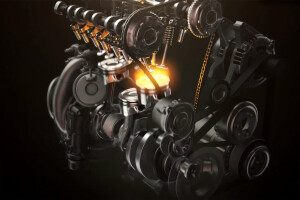 Advice
AdviceThree-cylinder engines are taking over, and here's why
They say size doesn’t matter, it’s the way you use it
-
Carnage
Carnage’s first Nugget Nationals car! – Carnage Plus episode 56
Telfo’s daily gets pinched again for some hillclimb trials
-
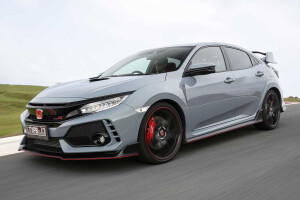 Features
FeaturesThe best hot hatches ever built
The best-ever game-changing hot hatches
-

2017 Renault Clio RS200 Cup: MOTOR Reader's Ride
-
.jpg)
Renault Clio steps out before Geneva debut
-

2019 Renault Clio breaks cover
-

Renault reveals RS Performance parts


